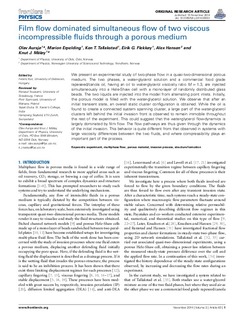| dc.contributor.author | Aursjø, Olav | |
| dc.contributor.author | Erpelding, Marion | |
| dc.contributor.author | Tallakstad, Ken Tore | |
| dc.contributor.author | Flekkøy, Eirik Grude | |
| dc.contributor.author | Hansen, Alex | |
| dc.contributor.author | Måløy, Knut Jørgen | |
| dc.date.accessioned | 2015-09-22T12:07:27Z | |
| dc.date.accessioned | 2016-05-31T11:48:51Z | |
| dc.date.available | 2015-09-22T12:07:27Z | |
| dc.date.available | 2016-05-31T11:48:51Z | |
| dc.date.issued | 2014-11-19 | |
| dc.identifier.citation | Frontiers in Physics 2014, 2:1-9 | nb_NO |
| dc.identifier.issn | 2296-424X | |
| dc.identifier.uri | http://hdl.handle.net/11250/2390912 | |
| dc.description.abstract | We present an experimental study of two-phase flow in a quasi-two-dimensional porous medium. The two phases, a water-glycerol solution and a commercial food grade rapeseed/canola oil, having an oil to water-glycerol viscosity ratio M = 1.3, are injected simultaneously into a Hele-Shaw cell with a mono-layer of randomly distributed glass beads. The two liquids are injected into the model from alternating point inlets. Initially, the porous model is filled with the water-glycerol solution. We observe that after an initial transient state, an overall static cluster configuration is obtained. While the oil is found to create a connected system spanning cluster, a large part of the water-glycerol clusters left behind the initial invasion front is observed to remain immobile throughout the rest of the experiment. This could suggest that the water-glycerol flow-dynamics is largely dominated by film flow. The flow pathways are thus given through the dynamics of the initial invasion. This behavior is quite different from that observed in systems with large viscosity differences between the two fluids, and where compressibility plays an important part of the process. | nb_NO |
| dc.language.iso | eng | nb_NO |
| dc.publisher | Frontiers Media | nb_NO |
| dc.rights | Navngivelse 3.0 Norge | * |
| dc.rights.uri | http://creativecommons.org/licenses/by/3.0/no/ | * |
| dc.title | Film flow dominated simultaneous flow of two viscous incompressible fluids through a porous medium | nb_NO |
| dc.type | Journal article | nb_NO |
| dc.type | Peer reviewed | nb_NO |
| dc.date.updated | 2015-09-22T12:07:27Z | |
| dc.subject.nsi | VDP::Matematikk og naturvitenskap: 400::Fysikk: 430::Kondenserte fasers fysikk: 436 | nb_NO |
| dc.subject.nsi | VDP::Mathematics and natural scienses: 400::Physics: 430::Condensed matter physics: 436 | nb_NO |
| dc.source.volume | 2 | nb_NO |
| dc.source.journal | Frontiers in Physics | nb_NO |
| dc.identifier.doi | 10.3389/fphy.2014.00063 | |
| dc.identifier.cristin | 1174979 | |
| dc.description.localcode | This Document is Protected by copyright and was first published by Frontiers. All rights reserved. it is reproduced with permission. © 2014 Aursjø, Erpelding, Tallakstad, Flekkøy, Hansen and Måløy. This is an open-access article distributed under the terms of the Creative Commons Attribution License (CC BY). The use, distribution or reproduction in other forums is permitted, provided the original author(s) or licensor are credited and that the original publication in this journal is cited, in accordance with accepted academic practice. No use, distribution or reproduction is permitted which does not comply with these terms. | nb_NO |

